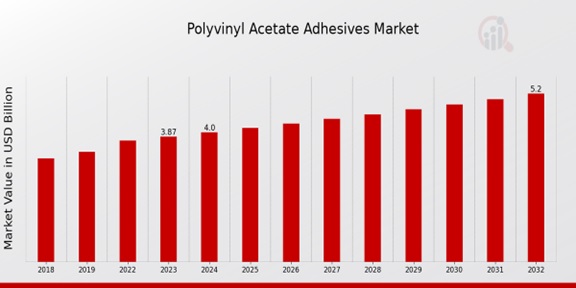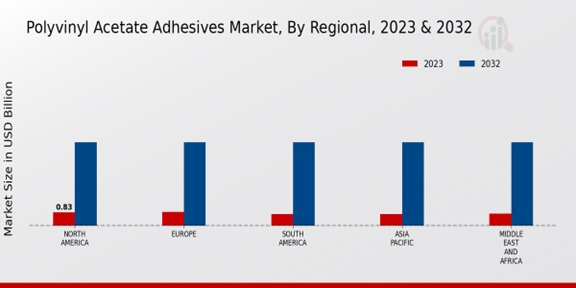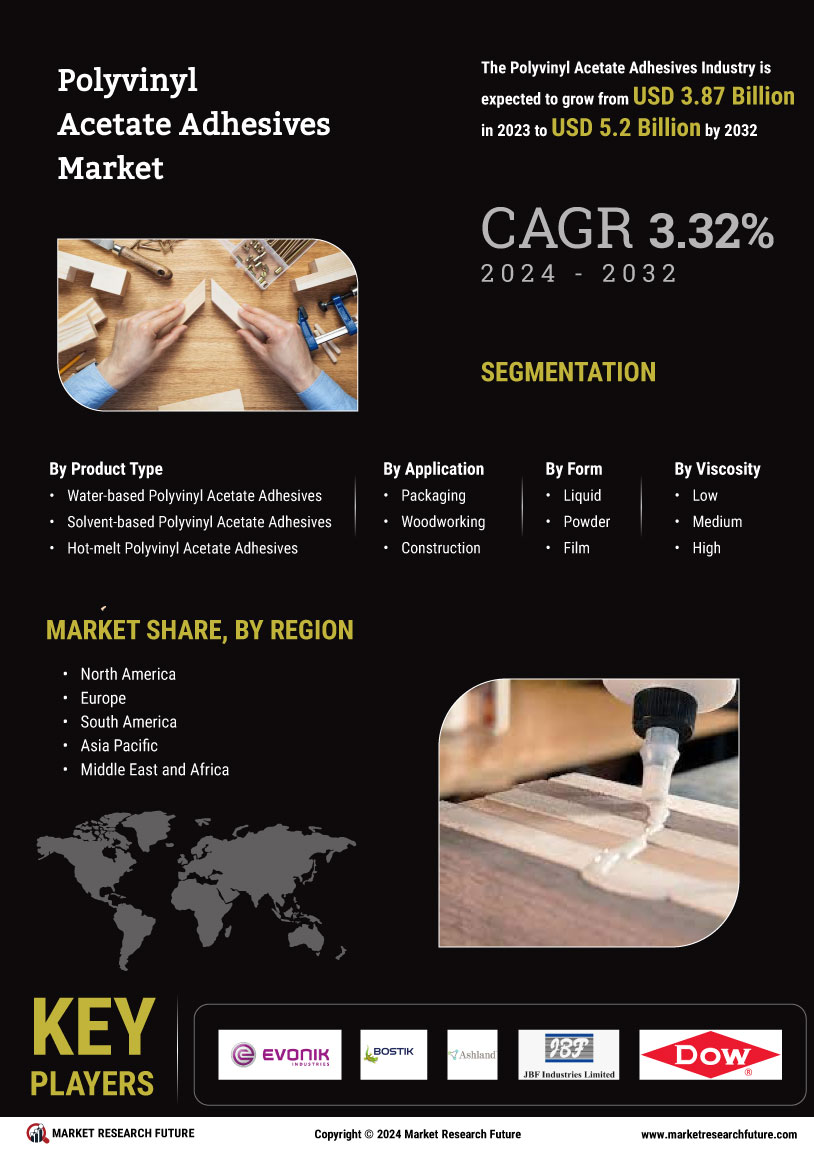Global Polyvinyl Acetate Adhesives Market Overview
The Polyvinyl Acetate Adhesives Market Size was estimated at USD 4.14 Billion in 2024. The Polyvinyl Acetate Adhesives Industry is expected to grow from USD 4.27 Billion in 2025 to USD 5.74 Billion by 2034. exhibiting a compound annual growth rate (CAGR) of 3.32% during the forecast period (2025 - 2034).
Key Polyvinyl Acetate Adhesives Market Trends Highlighted
The global Polyvinyl Acetate Adhesives Market is projected to grow significantly in the coming years, influenced by several key market trends. The increasing demand for adhesives in the packaging industry, particularly for food and beverage packaging, is one of the primary drivers of market growth. The rise of e-commerce and the subsequent surge in packaging requirements are also contributing to the demand for polyvinyl acetate adhesives.Furthermore, the growing construction sector is presenting opportunities for the market, as polyvinyl acetate adhesives are widely used in flooring, wallpapering, and woodworking applications. The increasing adoption of sustainable and eco-friendly practices in industries such as construction and packaging is also driving demand for polyvinyl acetate adhesives, which are known for their low toxicity and environmental compatibility. Recent advancements in adhesive technology, such as the development of high-performance, water-based adhesives, are creating new opportunities in the market. These adhesives exhibit excellent bonding strength, durability, and resistance to moisture and chemicals, making them suitable for various industrial applications.

Source Primary Research, Secondary Research, MRFR Database and Analyst Review
Polyvinyl Acetate Adhesives Market Drivers
- Rising Demand from the Packaging Industry
Polyvinyl acetate is one of the major bonding agents consumed by the packaging industry. A variety of PVAc bonders are used for several packaging needs, including carton sealing, labeling, and laminating. The anticipated growth of the packaging sector is expected to continue to drive PVAc's need in the years to come. The continued growth of the packaging sector is justified because demand for packed products continues to grow, especially in emerging economies.E-commerce has spurred demand for PVAc. In the final analysis, the packaging business advances, and product need grows, thereby increasing the demand for PVAc. The global packaging business is growing as new advances and solutions of the packaging business continue to emerge. Examples include the latest advances and predecessor solutions of the global PVAc adhesives industry, as well as those that absorb annexation stresses. Packaging advances and solutions especially include the use of modular packing that may consist of compositely made PVAc bonders.In this context, PVAc is used as a biodegradable and compostable non-toxic adhesive. Demand from the packaging business is one of the main reasons for the need for polyvinyl acetate. Reasoning from this impact, it is apparent that PVAc will continue to grow and dominate in the years to come.
Increasing Use in Construction Industry
The construction industry is one of the other major consumers of the PVAc adhesives. PVAc adhesives are predominantly used in various construction applications, including wood bonding, tile setting, and drywall installation. Moreover, the expansion of the construction industry is likely to positively impact the demand for PVAc adhesives in the years to come. The increasing need for housing, especially in developing regions, is one of the main forces that drive the growth of the construction industry.Additionally, the rising preference for remodeling and renovation activities is also likely to propel the demand for PVAc adhesives. PVAc adhesives are highly suitable for use in the construction industry as they are strong, resistant, easy to use, and relatively low cost. This is another factor that is fueling their adoption across the construction sector. Not only the construction sector, but the rising demand for PVAc adhesives in a multitude of sectors is one of the primary driving forces of the global Polyvinyl Acetate Adhesives Market Industry landscape.The trend is most likely to continue in the forthcoming decades.
Growing Demand from Automotive Industry
Another major consumer of PVAc adhesives is the automotive industry. PVAc adhesives find applications in several automotive applications, such as interior and exterior bonding and sound deadening. The demand for PVAc adhesives is expected to be driven by the growth of the automotive industry. The automotive industry is growing due to the increasing demand for automobiles in developing countries. Moreover, the popularity of electric vehicles is increasing the demand for PVAc adhesives in automotive applications.PVAc adhesives are ideal for automotive applications, as they are strong, long-lasting, and resistant to several different chemicals and solvents.They are also cheap. Hence, PVAc adhesives are used in automotive applications. The growing demand from the automotive industry is one of the main factors promoting the growth of the global PVAc adhesives market industry. PVAc adhesives are expected to be in high demand in the future due to the growth of the automotive industry.
Polyvinyl Acetate Adhesives Market Segment Insights
Polyvinyl Acetate Adhesives Market Product Type Insights
Product type segmentation of globally active polyvinyl acetate adhesives market includes water-based, solvent-based, and hot-melt segments. Water-based adhesives hold a large share of this market. Their advantages lie in cost-effectiveness, environmentally friendly nature, and multiple applications, ranging from paper and packaging to wood products and construction. Solvent-based adhesives have greater bonding strength, moisture and chemical resistance. Therefore, they are in high demand for applications in the automotive, aerospace, electronics industries, and more.Hot-melt adhesives, the newest type of PVAc, are chosen because of their rapid setting speed and strength, which makes them perfect for demanding applications in packaging, bookbinding, disposable products, and more. Over the years, the water-based segment is expected to remain the leader of the PVAc market as the world grows more concerned with environmental issues, at the same time searching for cost-effective solutions for many applications. However, the specialized applications and advantages of solvent-based and hot melts are guaranteed to show steady growth as well.

Source Primary Research, Secondary Research, MRFR Database and Analyst Review
Polyvinyl Acetate Adhesives Market Application Insights
The Global Polyvinyl Acetate Adhesives Market segmentation by application is broadly bifurcated into Packaging, Woodworking, Construction, Paper and Paperboard, Automotive, Bookbinding, and Others. Among these, the Packaging segment held the largest revenue share in 2023 and is anticipated to continue its dominance over the forecast period (2024-2032). The growth of the packaging industry, particularly in the food and beverage sector, is driving the demand for Polyvinyl Acetate Adhesives. Woodworking and Construction segments are expected to witness significant growth in the coming years, owing to the increasing construction activities and the rising demand for furniture and other wood products.
Polyvinyl Acetate Adhesives Market Form Insights
The Global Polyvinyl Acetate Adhesives Market is segmented based on form into liquid, powder, and film. Among these, the liquid form segment is expected to hold the majority of the market share in 2023 and is projected to maintain its dominance throughout the forecast period. The widespread use of liquid polyvinyl acetate adhesives in various industries, including woodworking, packaging, and construction, contributes to their popularity. The powder form segment is anticipated to witness steady growth over the forecast period. Powdered polyvinyl acetate adhesives offer advantages such as ease of application, extended shelf life, and reduced transportation costs.They are commonly used in the automotive and aerospace industries. The film form segment is expected to gain traction during the forecast period due to its unique properties. Polyvinyl acetate films exhibit high tensile strength, flexibility, and resistance to moisture and chemicals. They find applications in food packaging, electronics, and medical devices. Overall, the Global Polyvinyl Acetate Adhesives Market is expected to witness significant growth in the coming years, driven by increasing demand from end-use industries such as packaging, construction, and automotive.The market growth will also be influenced by the development of new and innovative applications for polyvinyl acetate adhesives.
Polyvinyl Acetate Adhesives Market Viscosity Insights
The viscosity of polyvinyl acetate (PVAc) adhesives plays a crucial role in determining their application and performance characteristics. PVAc adhesives are available in a range of viscosities, from low to medium to high, each with its own set of advantages and uses. Low-viscosity PVAc adhesives are characterized by their ease of application and ability to penetrate porous surfaces. They are commonly used in applications such as wood gluing, paper bonding, and packaging. With a Global Polyvinyl Acetate Adhesives Market revenue of USD 1.2 billion in 2023, the low-viscosity segment is projected to grow at a CAGR of 3.5% from 2024 to 2032, driven by increasing demand from the packaging industry.Medium-viscosity PVAc adhesives offer a balance of application ease and adhesive strength. They are suitable for a wide range of applications, including furniture assembly, bookbinding, and carpet installation. The Global Polyvinyl Acetate Adhesives Market segmentation data shows that the medium-viscosity segment is expected to reach a valuation of USD 1.5 billion by 2032, growing at a CAGR of 3.2% from 2024 onwards. High-viscosity PVAc adhesives are known for their high strength and durability. They are typically used in demanding applications such as structural bonding, metalworking, and automotive assembly.According to Global Polyvinyl Acetate Adhesives Market statistics, the high-viscosity segment is poised to witness a steady growth rate of 2.8% from 2024 to 2032, reaching a market value of USD 1.4 billion by the end of the forecast period. The choice of PVAc adhesive viscosity depends on the specific application requirements. Low-viscosity adhesives are ideal for applications requiring easy penetration and spreadability, while medium-viscosity adhesives offer a good balance of application ease and strength. High-viscosity adhesives are recommended for applications demanding high strength and durability.By understanding the viscosity characteristics of PVAc adhesives, manufacturers and end-users can optimize their selection and usage for optimal performance and cost-effectiveness in the Global Polyvinyl Acetate Adhesives Market industry.
Polyvinyl Acetate Adhesives Market Regional Insights
The regional segmentation of the Global Polyvinyl Acetate Adhesives Market includes North America, Europe, APAC, South America, and MEA. North America holds a significant market share due to the presence of a large construction industry and the increasing demand for wood adhesives in the region. Europe is expected to witness steady growth due to the rising adoption of Polyvinyl Acetate adhesives in the automotive industry. APAC is projected to be the fastest-growing region, driven by the expanding construction and packaging industries in countries like China and India.South America and MEA are expected to experience moderate growth due to increasing urbanization and industrialization.

Source Primary Research, Secondary Research, MRFR Database and Analyst Review
Polyvinyl Acetate Adhesives Market Key Players And Competitive Insights
The Polyvinyl Acetate Adhesives Market is majorly concentrated, with leading players working to produce innovations in sync with consumer needs. These top players invest heavily in research and development to enhance the functionality and efficiency of their products. The latest report on the Polyvinyl Acetate Adhesives Market industry highlights major players’ scope for investment in the market. The Polyvinyl Acetate Adhesives Market industry is actively witnessing strategic partnerships, joint ventures, and acquisitions. Leading players are also inclined toward expanding their global presence through strategic alliances and collaborations. The Polyvinyl Acetate Adhesives Market Competitive Landscape comprises a mix of well-established and emerging players, each having a unique offering and strategy.
Henkel AG & Co. KGaA can be regarded as a significant player in the Polyvinyl Acetate Adhesives Market besides other industrial and consumer adhesives. Major factors contributing to the dominance of the company in the market are its strong brand presence and its vast global reach. The company continues to lead the Polyvinyl Acetate Adhesives Market on the back of its investments in research and development. The company also provides its customers with effective solutions with the customization of its products according to the varied needs of the industries. Additionally, Henkel also emphasizes sustainability and environmental stewardship.
Avery Dennison Corporation exemplifies another significant player in the Polyvinyl Acetate Adhesives Market providing a rich assortment of pressure-sensitive adhesives. Being a pioneer company in these materials, some of Avery Dennison’s products are polyvinyl acetate-based adhesives. The company’s significant contribution in the Polyvinyl Acetate Adhesives Market can be associated with advancement in materials sciences and technologies in varied manufacturing procedures. The company’s rich network of customer relations at the global level also aids in maintaining its dominant presence in the market. The company continues to stay relevant in the market with innovations and investments in collaborations.
Key Companies in the Polyvinyl Acetate Adhesives Market Include
- Evonik Industries AG
- Bostik S.A.
- Ashland Inc.
- JBF Industries Ltd.
- Dow Chemical Company
- Henkel AG Co. KGaA
- RPM International Inc.
- Arkema S.A.
- B. Fuller
- Avery Dennison Corp.
- BASF SE
- Sika AG
- AkzoNobel N.V.
- 3M
Polyvinyl Acetate Adhesives Market Industry Developments
BASF has recently developed PVA adhesives with enhanced durability and adhesion properties for the packaging industry. These innovations come hand in hand with the growing trend for sustainable adhesive solutions, Which play an advantageous role in meeting the expanding demand for environmentally friendly adhesives.
In line with their sustainable goals, Beardow & Adams launched an eco-friendly PVA adhesive that lowers solvent emissions in March 2024, which meets the evolving environmental policies.
Bostik still prioritizes high-performance adhesives that target the construction and automobile industries. A new PVA adhesive product, which was introduced in April 2024, is said to improve bonds in the presence of moisture.
However, in January 2024, both companies unveiled plans for a merger with the goal of building cutting-edge adhesive technology. The synergy aims at fostering the adoption of antibacterial and organic adhesive options in the packaging and car manufacturing sectors.
In February 2024, Bostik reached an agreement to partner with Jowat Corporation in the development of high-performance, sustainable adhesives for the electronics industry to serve the heightened demand for strong bonding materials.
One such company was H.B. Fuller which partnered with Lord Corporation for the development of novel PVA-based adhesives specifically for the automotive, lightweight material industry and joined the competition in March 2024.
In April 2024, these two companies signed a strategic agreement with the aim of developing green adhesives for the packaging industry. Their joint objectives include the improvement of recyclability and the minimization of the ecological effects of their products.
Dynea Oy (Finland) and Momentive Specialty Chemicals Inc. (US): A joint venture in May 2024 enabled Dynea and Momentive to develop a new generation of PVA adhesives for building and furniture industries with better longevity and water resistance.’’
Tex Year Industries (Taiwan) and Costchem srl (Italy): These companies joined forces in July 2024 to develop a cheaper method of manufacturing PVA adhesives for the textile and paper sectors.’’
Polyvinyl Acetate Adhesives Market Segmentation Insights
Polyvinyl Acetate Adhesives Market Product Type Outlook
- Water-based Polyvinyl Acetate Adhesives
- Solvent-based Polyvinyl Acetate Adhesives
- Hot-melt Polyvinyl Acetate Adhesives
Polyvinyl Acetate Adhesives Market Application Outlook
- Packaging
- Woodworking
- Construction
- Paper and Paperboard
- Automotive
- Bookbinding
Polyvinyl Acetate Adhesives Market Form Outlook
Polyvinyl Acetate Adhesives Market Viscosity Outlook
Polyvinyl Acetate Adhesives Market Regional Outlook
- North America
- Europe
- South America
- Asia Pacific
- Middle East and Africa
| Report Attribute/Metric |
Details |
| Market Size 2024 |
4.14 (USD Billion) |
| Market Size 2025 |
4.27 (USD Billion) |
| Market Size 2034 |
5.74 (USD Billion) |
| Compound Annual Growth Rate (CAGR) |
3.32% (2025 - 2034) |
| Report Coverage |
Revenue Forecast, Competitive Landscape, Growth Factors, and Trends |
| Base Year |
2024 |
| Market Forecast Period |
2025 - 2034 |
| Historical Data |
2020 - 2024 |
| Market Forecast Units |
USD Billion |
| Key Companies Profiled |
Evonik Industries AG, Bostik S.A., Ashland Inc., JBF Industries Ltd., Dow Chemical Company, Henkel AG Co. KGaA, RPM International Inc., Arkema S.A., H.B. Fuller, Avery Dennison Corp., BASF SE, Sika AG, AkzoNobel N.V.,3M |
| Segments Covered |
Product Type, Application, Form, Viscosity, Regional |
| Key Market Opportunities |
Increasing demand for sustainable adhesives Rising use in packaging and converting applications Growing demand in emerging economies Development of new and innovative products Expansion of ecommerce and online distribution channels |
| Key Market Dynamics |
1 Rising demand from the packaging industry2 Growing construction sector3 Increasing disposable income4 Environmental concerns5 Technological advancements |
| Countries Covered |
North America, Europe, APAC, South America, MEA |
Frequently Asked Questions (FAQ) :
The global Polyvinyl Acetate Adhesives market is expected to reach a valuation of USD 4.14 billion in 2024 and is projected to grow at a CAGR of 3.32% to reach USD 5.74 billion by 2034.
Asia-Pacific is expected to dominate the global Polyvinyl Acetate Adhesives market throughout the forecast period, owing to the increasing demand from the packaging and construction industries in the region.
The increasing demand for eco-friendly adhesives, the growing packaging industry, and the rising demand from the construction sector are the key growth drivers of the global Polyvinyl Acetate Adhesives market.
Some of the key competitors in the global Polyvinyl Acetate Adhesives market include Henkel AG Co. KGaA, The Dow Chemical Company, H.B. Fuller Company, Sika AG, and Bostik SA.
Polyvinyl Acetate Adhesives find applications in various industries, including packaging, construction, woodworking, automotive, and paper converting.
The global Polyvinyl Acetate Adhesives market faces challenges such as stringent environmental regulations, the availability of substitutes, and the fluctuating prices of raw materials.
The global Polyvinyl Acetate Adhesives market is expected to grow at a steady pace during the forecast period, driven by the increasing demand from various industries and the development of new applications.
The emerging trends in the global Polyvinyl Acetate Adhesives market include the development of water-based adhesives, the use of bio-based materials, and the adoption of advanced technologies for manufacturing and application.
The key opportunities for growth in the global Polyvinyl Acetate Adhesives market lie in the expanding packaging and construction industries, the increasing demand for eco-friendly adhesives, and the development of new applications.
The potential risks to the growth of the global Polyvinyl Acetate Adhesives market include the economic downturn, geopolitical uncertainties, and technological advancements that may lead to the development of substitutes.

















